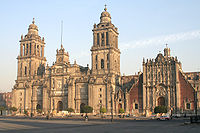Portal:Mexico/Selected article/18

The Metropolitan Cathedral of the Assumption of Mary of Mexico City (Spanish: Catedral Metropolitana de la Asunción de María) is the largest cathedral in the Americas, and seat of the Roman Catholic Archdiocese of Mexico. It is situated atop the former Aztec sacred precinct near the Templo Mayor on the northern side of the Plaza de la Constitución in Downtown Mexico City. The cathedral was built in sections from 1573 to 1813 around the original church that was constructed soon after the Spanish conquest of Tenochtitlan, eventually replacing it entirely. Spanish architect Claudio de Arciniega planned the construction, drawing inspiration from Gothic cathedrals in Spain.
The cathedral has four façades which contain portals flanked with columns and statues. The two bell towers contain a total of 25 bells. The tabernacle, adjacent to the cathedral, contains the baptistery and serves to register the parishioners. There are two large, ornate altars, a sacristy, and a choir in the cathedral. Fourteen of the cathedral's sixteen chapels are open to the public. Each chapel is dedicated to a different saint or saints, and each was sponsored by a religious guild. The chapels contain ornate altars, altarpieces, retablos, paintings, furniture and sculptures. The cathedral is home to two of the largest 18th-century organs in the Americas. There is a crypt underneath the cathedral that holds the remains of many former archbishops.
